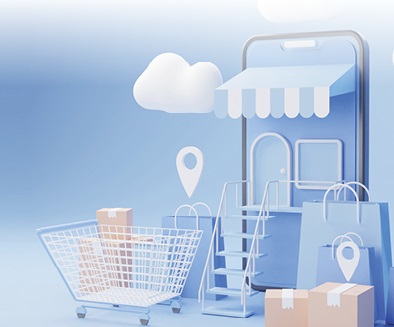The next normal in retail industry

Malaysia’s retail industry has been heavily impacted by the Covid-19 outbreak in 2020. Faced with a -16.3% contraction in retail sales recorded last year, it is one of the sector’s worst performances ever recorded since the Asian Financial Crisis.
As the pandemic forces people to stay home and retail outlets shutter, consumers have shifted the way they spend and at the same time, driving retailers to adopt an innovative approach to keep their businesses afloat.
Following the country’s increase in vaccination rate and the easing of lockdown restrictions in some states, retailers must be prepared as they welcome eager customers to their stores.
Reopening of stores means retailers must rethink their assortments and channel strategies to match the shifts in consumer preferences and behaviours. More importantly, they must implement appropriate health and safety protocols to protect staff and customers while Covid-19 is prevalent in the community.
Trends in the retail landscape will take time to normalise. Key trends which retailers are expected to embrace on the path of recovery include the following observations:
1. Acceleration of e-commerce

The closure of physical stores due to lockdowns and social distancing measures have led consumers to resort to online shopping, which in turn has reinforced the e-commerce market growth in Malaysia.
According to the Department of Statistics Malaysia, income from e-commerce transactions recorded RM896.4 billion in 2020, an increase of 32.7% compared to 2019 (RM675.4 billion). Recorded e-commerce transactions in the first quarter of 2021 were RM254.6 billion which is an increase of 30% year-on-year.
Consumer behaviour changes during the pandemic have resulted in retailers having to re-strategise their business models by incorporating online services to drive their businesses in the new normal.
Customers will remain glued to the online platform for years to come and the acceleration of e-commerce will continue as retailers solve supply chain issues.
For retailers, the economics of e-commerce remain challenging due to operations, infrastructure, shipping offerings and price competition. It is crucial for retailers to take a long-term view of e-commerce profitability and make investments to meet the growing demand.
2. In-store digital experience

The digital shopping experience has shifted customer preferences and expectations. Along with easy access and convenience, consumers find that there are a wealth of product information, reviews and recommendations when purchasing online.
Moving forward, to provide a truly omni-channel experience, brick-and-mortar stores will adopt elements of the online experience to the retail stores. This involves a couple of other trends such as artificial intelligence (AI), robotics, virtual reality (VR) and augmented reality (AR).
Through AI, for instance, retailers may adopt in-store shopping guidance to help customers easily locate merchandise, answer questions and pay via mobile apps.
In fashion outlets, provision of virtual mirrors and mobile apps that allow customers to visualise products without entering the physical fitting room or interacting with the staff will be more commonplace.
Self-checkout stores have become more common and initiatives for consumers to order, pay in-store and have goods delivered to their homes could be the next normal.
3. Safety, health and cleanliness

After months of lockdown, consumers may feel less confident about visiting enclosed shopping malls again. Apart from the hassle-free shopping experience, today’s consumers demand a safe and clean environment while shopping.
The key to getting them back into malls will be for retailers to invest in customers’ safety and health and to provide tools and applications that lead to a smoother shopping experience.
While the national SOPs such as wearing face masks and social distancing measures should be adhered to, consumer expectations would include scannable registration QR codes, hand-sanitising stations, checkout barriers and occupancy limits.
For enclosed and air-conditioned retail outlets, the building’s indoor air quality performance would be of greater importance for both retailers and consumers.
Portable indoor air purifiers are strongly recommended as they increase natural airflow and improve ventilation. HVAC (heating, ventilation and air conditioning) systems in malls should always be regularly inspected, maintained and cleaned.
4. Experience-driven destination

The future of shopping is more than just shopping but also a way to get together in the community and escape the digital world. Consumers will likely be craving more social interaction.
Shopping malls are meeting places for the community and a multi-purpose destination that offer extensive leisure activities. A tenant-mix of complementary uses allows customers to have an interactive experience. Shopping malls could provide short-term pop-ups, art exhibitions and community lounge spaces with a meditative and calm environment.
In China for instance, the TX Huaihai Youth Energy Centre is a great example of how the world of fashion and arts are integrated into an interactive space. This curated retail mall offers a museum-like innovative environment with the collaboration of brands and artists.
5. Open spaces as valuable amenities

The pandemic has brought to the fore the importance of open spaces and increased awareness of building ventilation. Designing an environment with access to open air, ventilated spaces and less congested retail spaces will be key trends in the retail sector.
Retail centres with a distributed network of public spaces will thrive and restaurants will embrace outdoor seating as much as possible.
If the al-fresco dining spaces were merely optional spaces for customers in the past, the next normal would probably make these open-air dining spaces the new default in customers’ preference.
More outdoor retail concepts will emerge as customers seek more comfort in shopping. Retail malls with ample outdoor spaces will become more sought after for the consumer.
Opportunity to be Innovative
Though 2021 remains a challenging year for the retail industry, it allows the opportunity to be innovative in exploring new business formats. Shopping mall owners and retailers could leverage this opportunity to build on their omni-channel strategies, incorporate experiential elements, embrace digitalisation and rethink the spatial design of their stores.

Newly-planned shopping malls will need to consider integration and connectivity as well as a safe and healthy shopping environment for their visitors and occupiers.
These initiatives will help the retail industry recover in the medium to long term to accommodate changing patterns of consumer behaviour in the retail landscape.
This story first appeared in the EdgeProp.my E-weekly on Oct 29, 2021. You can access back issues here.
Get the latest news @ www.EdgeProp.my
Subscribe to our Telegram channel for the latest stories and updates
Never miss out
Sign up to get breaking news, unique insights, event invites and more from EdgeProp.
Latest publications
Malaysia's Most
Loved Property App
The only property app you need. More than 200,000 sale/rent listings and daily property news.
